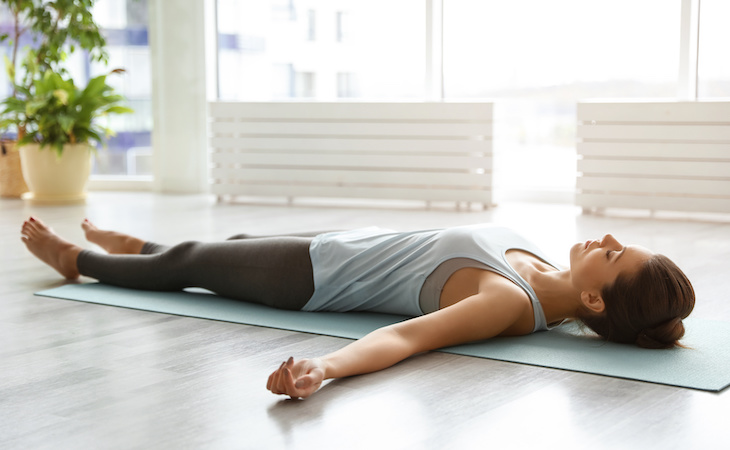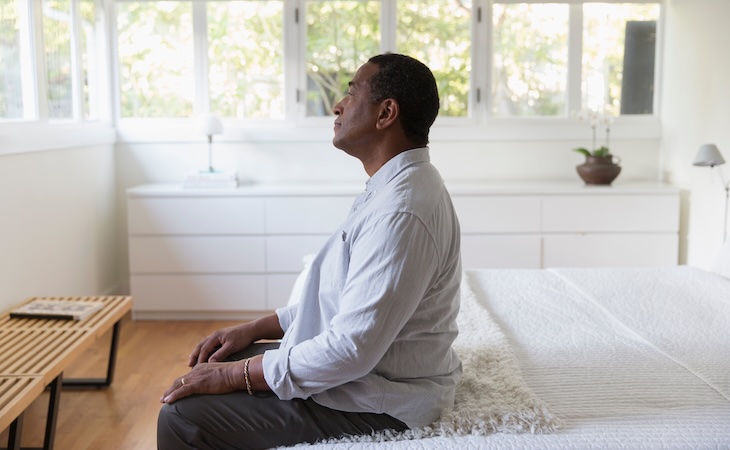There are several challenges that can make it hard to fall (and stay!) asleep. Anxiety, insomnia, racing thoughts…they can all keep you up at night—and prevent you from getting the sleep you need to feel and function your best.
If you’re struggling with sleep, it’s important to find strategies to help you get the shuteye you need. One of those strategies? Progressive muscle relaxation (PMR).
Many people successfully use progressive muscle relaxation for sleep. But what, exactly, is progressive muscle relaxation for sleep— and how does it work? Plus, how can you tap into this method and use it to get better sleep?
Keep reading for everything you need to know about progressive muscle relaxation for sleep.
What is progressive muscle relaxation?
First things first: What is progressive muscle relaxation?
“Progressive muscle relaxation (PMR) is a widely used relaxation technique targeting the activation and release of major muscle groups,” says Pooja Patel, a licensed occupational therapist and founder of Aging Together.
Patel specializes in working with older adults and has experience teaching PMR to clients for improved sleep. “It involves squeezing and releasing different muscles in a step-by-step way,” she explains.
“Progressive muscle relaxation (PMR) is a widely used relaxation technique targeting the activation and release of major muscle groups.”
-Pooja Patel, a licensed occupational therapist and founder of Aging Together
That step-by-step process involves starting at one end of the body, focusing on tensing and releasing one muscle group at a time, and then moving on to the next group.
“By relaxing the body and either with eyes closed or open, one can focus attention on the toes and slowly bring that sensation of calm up through the legs, torso, and so on [up through the entire body],” says Nancy B. Irwin, PsyD, licensed clinical psychologist and certified hypnotherapist.
How does progressive muscle relaxation work?
So, what does all this muscle tension releasing actually do—and how can it help improve your sleep?
“PMR is based on the mind-body connection and the principle that physical relaxation can lead to mental calmness,” says Patel.
Here’s the deal: When you’re stressed or anxious, your muscles tense up. By deliberately tensing and then relaxing these muscles, you can achieve a deeper state of relaxation.
“This process helps increase awareness of the sensation of tension versus relaxation in the body,” says Patel.
In addition to relaxing the body, progressive muscle relaxation can also influence the brain in a way that promotes better sleep. PMR slows the brain waves down to an alpha state, says Irwin.
Unlike the faster-moving brain waves we experience while fully alert and awake, “Alpha is slower, allowing the brain to take the suggestion of relaxation and send that to each muscle as we move from the toes to the top of the head slowly, much like a massage therapist would do to release tension,” explains Irwin.
Benefits of progressive muscle relaxation for sleep
According to the US Department of Veterans Affairs, “PMR is a recommended practice to relax the body and mind at bedtime to fall asleep more easily and get a deeper night’s sleep.”
But how does this practice help improve your rest?
PMR offers a variety of benefits that support better sleep; for example, recent research finds that PMR is effective in reducing stress, anxiety, and depression—all of which can help you get better sleep.
More specifically, progressive muscle relaxation can help you get better sleep by:
- Reducing physical tension. “By systematically relaxing muscle groups, PMR helps release physical tension that may interfere with falling asleep,” says Patel.
- Calming the mind…“The focus on physical sensations can help quiet racing thoughts that often keep people awake,” says Patel.
- …and the body. “PMR triggers the body’s natural relaxation response, lowering heart rate and blood pressure, which promotes sleep,” says Patel.
- Lowering anxiety. “It is difficult for the body to relax if the mind is anxious because it gives cues to the body to be on ‘high alert,’” says Irwin. “When one implements [PMR], their brain waves will naturally slow down, allowing sleep to naturally take over.”
- Reducing stress. “PMR is an effective stress management technique, helping to alleviate stress-related sleep disturbances,” says Patel.
Plus, research shows PMR may increase time spent in restorative, slow-wave sleep and offer an immediate linear trend to physiological relaxation.
Studies also find that progressive muscle relaxation may improve sleep quality in people living with chronic diseases and improve sleep onset latency in elite athletes (or, in other words, PMR can help elite athletes fall asleep faster).
How to practice progressive muscle relaxation for sleep
Clearly, progressive muscle relaxation can offer huge benefits for sleep—but how do you practice it?
- Find a comfortable position. Sit or lie down in a quiet place where you can relax without distractions.
- Start with your feet. Focus on your feet and toes. Tense the muscles as tightly as you can for about five to 10 seconds, then slowly release the tension. Notice the sensation of relaxation.
- Focus on one muscle group at a time. Progressive muscle relaxation is, as the name suggests, progressive—which means you want to focus on one muscle group before moving on to the other. “It may take some practice at first, but try not to tense muscles other than the one you’re working on,” says Patel.
- Move up the body. Gradually work your way up through your legs, abdomen, arms, and hands. For each muscle group, tense and then release the muscles, paying attention to how each group feels.
- Practice deep breathing. While tensing and releasing each muscle group, take slow, deep breaths. Inhale as you tense the muscles and exhale as you relax them.
- Finish with a full-body scan. After you’ve worked through all the muscle groups, take a moment to focus on your entire body. Notice the overall sense of relaxation and let go of any remaining tension.
If you’re new to PMR, you may also want to try a guided progressive muscle relaxation for sleep. Having auditory cues can help guide you as you move through each area of the body—and if the audio has soothing music, it can help you feel more relaxed (which, in turn, can make it easier to fall asleep).
Want to give PMR a try? Check out these progressive muscle relaxation audio clips for sleep:
You may also find guided progressive muscle relaxation on meditation or mindfulness apps (like Calm or Headspace).
Also, while progressive muscle relaxation is generally a safe practice, it’s not for everyone. “Consult with your doctor first if you have a history of muscle spasms, back problems, or other serious injuries that may be aggravated by tensing muscles,” suggests Patel.
FAQs
Does progressive muscle relaxation help you sleep?
Yes! Progressive muscle relaxation supports sleep in a variety of ways—for example, by reducing anxiety and stress.
How do you do progressive muscle relaxation step-by-step?
To practice progressive muscle tension, start at the bottom of your body, tensing the muscles in your feet and toes for five to 10 seconds. Then, release, and move upwards through your body, tensing each muscle group for five to 10 seconds before moving on to the next.
Once you’ve moved your way through the entire body, scan your body for any signs of remaining tension—and, if necessary, tense and release those muscle groups for an additional five to 10 seconds.
Did you know that massage can also help you catch Z’s? Next, learn all about the sleep and health benefits of massage.




